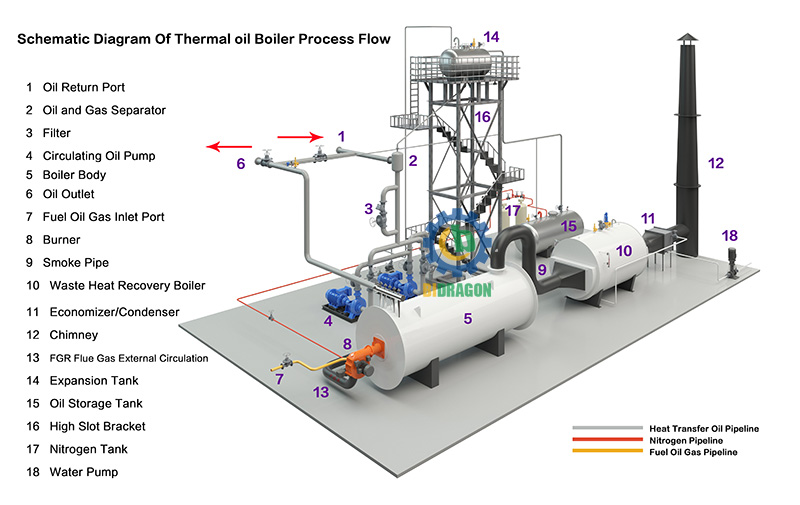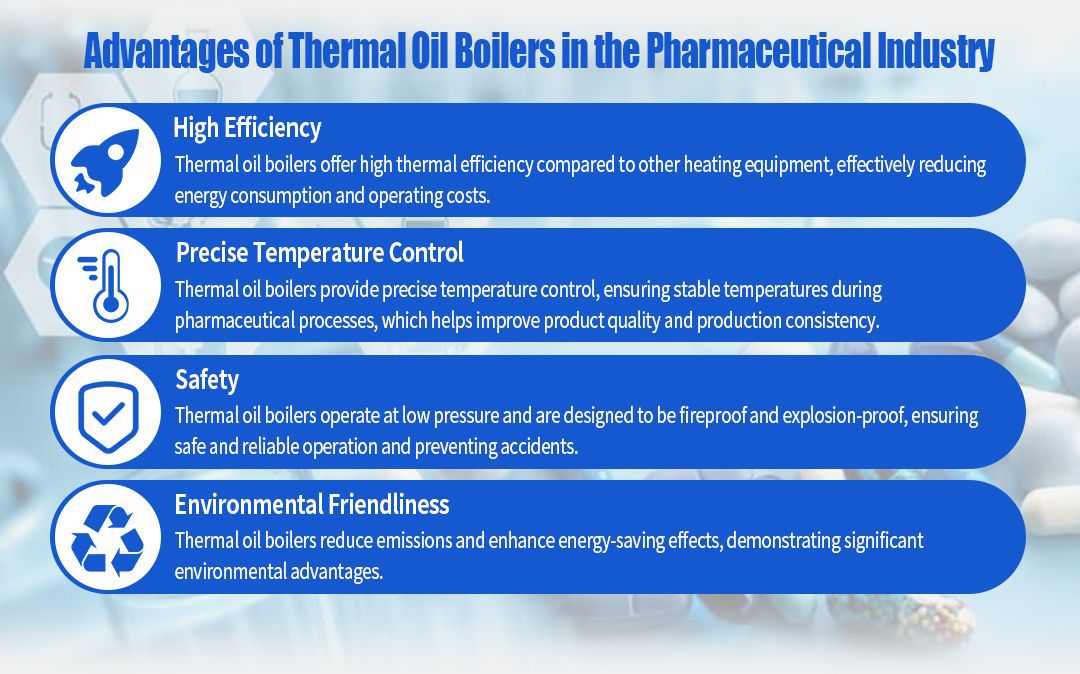In the pharmaceutical industry, the production of drugs on the temperature control requirements are extremely stringent, from the raw material reaction to the processing of finished products, each link requires accurate and stable heat source. Thermal oil furnace as a heat transfer medium with thermal oil as thermal energy equipment, with its unique performance advantages, in the pharmaceutical field plays an indispensable role.
The Importance of Thermal Oil Boiler in Pharmaceutical Industry
The distillation, drying, reactor heating and other key aspects of the pharmaceutical process rely on a stable high-temperature environment. The thermal oil furnace heats the thermal oil by burning natural gas, diesel fuel and other fuels, and then transfers the heat to the terminal equipment, realizing high temperature and low pressure operation, and guaranteeing the safety and stability of the production process. Its precise temperature control characteristics ensure the quality of pharmaceutical production, while the high efficiency and energy saving features can significantly reduce the energy costs of pharmaceutical companies, while meeting the industry's strict safety and environmental standards.
Working Principle of Thermal Oil Boiler

Fuel Combustion and Heat Transfer
The fuel enters the storage hopper before the combustion chamber, and is sent into the combustion chamber through the chain device, and the air supply fan provides combustion air to fully combust the fuel to produce high-temperature hot smoke. After entering the oil furnace, the hot smoke flows around the internal heat transfer pipe and heats the heat transfer oil inside the pipe. After transferring heat, the hot smoke is sucked into the air heater by the fan to heat the combustion air entering the combustion chamber to improve the combustion efficiency, and finally discharged from the chimney after the exhaust gas treatment system meets the standard.
Thermal Oil Circulation System
The cold thermal oil after use is pumped back by the circulating oil pump, sent to the oil furnace for heating and warming, and then transported back to the heat-using equipment. The automatic gas separation device in the system can effectively separate the gas in the heat transfer oil to ensure the stable operation of the system; the replenishment pipeline is responsible for replenishing the heat transfer oil to maintain the system with sufficient oil.
Ash collection system
Depending on the type of fuel and the amount of ash produced, the ash collection system has different designs. The large amount of ash produced by combustion is collected at the back of the boiler, and the light ash is captured with the flue gas through the air heater and exhaust gas treatment system.
Specific Applications Of Thermal Oil Boiler In The Pharmaceutical Industry
Reactor Heating
In the pharmaceutical reaction process, the chemical reaction in the reactor requires extremely high temperatures. For example, in the production of antibiotics, the reaction temperature must be strictly controlled in a specific zone to ensure reaction efficiency and product purity. The stable and uniform high-temperature heat source provided by the thermal oil furnace can precisely control the temperature of the reactor to ensure that the entire reaction process is carried out smoothly, thus improving product quality and yield.
Distillation Process
Distillation is a key step in pharmaceutical purification. Heat conduction oil furnace provides efficient and stable heat source for distillation equipment, realizes precise temperature control, and greatly improves distillation efficiency. In the extraction of essential oils, it allows the distillation equipment to quickly reach the required temperature, reducing energy consumption, while ensuring that the extracted essential oils are more pure and more efficient.
Drying System
Drying is a necessary part of removing water and solvents in the production process of pharmaceuticals and chemical reagents. The high temperature heat source of the thermal oil furnace makes the drying process more efficient and uniform. When drying powdered drugs, it can significantly shorten the drying time and improve the production efficiency, while ensuring that the quality of the dried product is consistent.
Melting Process
Part of the drug production needs to melt solid raw materials into liquid state for subsequent processing. The stable high temperature environment created by the heat conduction oil furnace provides a reliable guarantee for the melting process. For example, in the production of pharmaceutical wax products, it can maintain a stable temperature in the melting vessel, and improve the melting efficiency and stability.
Sterilization
Pharmaceutical production requires strict sterilization of equipment and environment. The high-temperature heat source generated by the heat conduction oil furnace can effectively kill microorganisms, provide continuous high-temperature steam for equipment sterilization, ensure that the microorganisms on the surface of the equipment are completely removed, and guarantee the safety and hygiene of the production process.
Competitive Advantages of Thermal Oil Boiler
Compared with traditional steam boiler, heat transfer oil furnace shows obvious advantages in many dimensions. System pressure, thermal oil furnace operating at atmospheric pressure, without the need for pressure vessel registration; thermal efficiency of up to 90% or more, far more than 75 - 85% of the steam boiler; temperature control accuracy of up to ± 0.5 ℃, the steam boiler is only ± 3 - 5 ℃; start-up speed, 15 minutes to reach the temperature, while the steam boiler needs more than 45 minutes; In addition, the thermal oil furnace maintenance costs are low, without the problem of condensate corrosion, but also free of the annual inspection costs of pressure vessels, saving Pressure vessel annual inspection fees, saving a lot of money.
6 Competitive Advantages of Steam Boilers
|
Dimension |
Thermal Oil Boiler |
Traditional Steam Boiler |
|
System Pressure |
Atmospheric pressure operation |
Requires pressure vessel registration |
|
Thermal Efficiency |
≥90% |
75-85% |
|
Temperature Accuracy |
±0.5℃ |
±3-5℃ |
|
Start-up Time |
15 minutes to reach temperature |
Over 45 minutes |
|
Maintenance Cost |
Low (No condensation corrosion) |
High (Regular descaling needed) |
|
Compliance Cost |
Exempt from annual inspections |
Annual inspection fees: ¥30k-80k |
Unique Advantages Of Thermal Oil Boiler In The Pharmaceutical Industry

Ease of Operation and Low Maintenance
Thermally Conducted Oil lubricates and reduces the need for equipment maintenance, eliminating the need for frequent monitoring and chemical treatments to prevent corrosion, and reducing operational difficulties and maintenance costs.
Energy Saving
Compared to steam heaters, thermal oil furnaces can reduce energy consumption by 20%, avoiding heat loss during feedwater preheating, sewage discharge and steam trapping.
Environmentally friendly
The higher thermal efficiency of the thermal oil furnace results in lower total emissions, which is in line with the increasingly stringent environmental requirements of the pharmaceutical industry.
High Temperature Operation
The high boiling point of the thermal oil enables the furnace to operate over a wide temperature range from - 40°C to 400°C, with precise regulation of different temperatures via the secondary control loop.
High Safety
The lower operating pressure makes the thermal oil furnace free from the risk of explosion due to pressure, which guarantees the safety of the operator.
Maintenance and Care of Heat Transfer Oil Furnace
Daily Maintenance
Everyday, you need to check the ignition and combustion stability of the burner, monitor the level of heat transfer oil, and monitor the system pressure and temperature in real time to ensure that they are within the safety range, as well as checking the operation of the electronic control system. It is also vital to keep the boiler and auxiliary equipment clean. Regularly clean dust and oil to prevent affecting heat dissipation and combustion performance.
Periodic Inspection and Maintenance
Regularly inspect and replace worn parts, clean carbon and impurities from the boiler, coils and piping, and reassemble and fully test the system after completing maintenance. Safety precautions should be taken when operating, keep the working area ventilated and use suitable tools to avoid equipment damage and personnel injury.
Common Problems Troubleshooting and Solution
When there are problems such as incomplete combustion, abnormal oil level, pipe leakage, abnormal temperature and pressure, etc., it is necessary to take appropriate measures for different reasons, such as checking and cleaning the burner, repairing leakage points, replacing the aging pipes, and overhauling the temperature and control system. In case of emergency, the system should be shut down immediately, isolate the dangerous area, report the fault and record the details, and carry out emergency repairs as soon as possible.
Safety Standards For Using Industrial Boilers In The Pharmaceutical Industry
Strict safety standards need to be followed when using industrial boilers in the pharmaceutical industry. Choose a safe location to install the boiler to ensure the safety of personnel and the environment; regular inspection and maintenance according to the manufacturer's specifications; strict adherence to safe operating procedures; and the development of a comprehensive emergency plan to cope with equipment failures, to maximize the protection of personnel safety and production stability.
Conclusion
Thermally Conducted Oil Furnace has become an indispensable and important equipment for pharmaceutical production by virtue of its wide range of applications in multiple segments of the pharmaceutical industry, significant performance advantages, perfect maintenance system and strict safety standards. With the continuous development of the pharmaceutical industry, the production process and equipment requirements continue to improve, thermal oil furnace will also be optimized and upgraded in technological innovation, to provide more powerful support for the high-quality development of the pharmaceutical industry.























